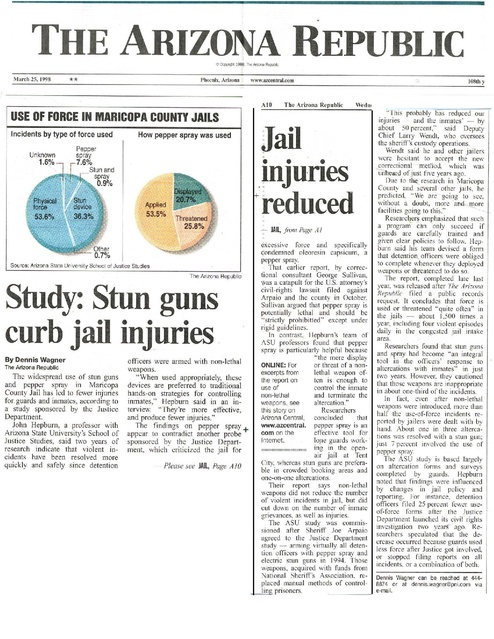Taser Az Stun Guns Curb Jail Injuries 1998
Download original document:

Document text

Document text
This text is machine-read, and may contain errors. Check the original document to verify accuracy.
THE ARIZONA REPUBLIC March 25,1998 ** Phoenix, Arimna www.az«ntral.com AIO The Arizona Republic USE OF FORCE IN MARICOPA COUNTY JAILS Incidents by type of force used Pepper spray Unknown 1.6%- How pepper spray was used •• • ,~nJunes ,-7.6% 1 .......!~" Stun and spray 0.9% 53.5% Source: Arizona State University School of Justice Studies The Arizona Republic Study: Stun guns curb jail injuries By Dennis Wagner The widespread use of stun guns and pepper spray in Maricopa County Jail has led to fewer injuries for, guards and inmates, according to a study sponsored by the Justice Department. John Hepburn, a professor with Arizona State University's School of Justice Studies, said two years of research indicate that violent incidents have been resolved more quickly and safely since detention officers were armed with non-lethal weapons. "When used appropriately, these devices are preferred to traditional hands-on strategies for controlling inmates," Hepburn said in an interview. "They're more effective, and produce fewer injuries." The findings on pepper spray + appear to contradict another probe sponsored by the lustice Department, which criticized the jail for ~ Please see JAIl, Page A10 WCdlll "This probably has redvccd our injuries - and the inmates' - by aboLlt 50 percent." said Deputy Chief Larry Wendt. who oversees the sheriff's custody operations. Wendt said he and other jailers were hesitant to accept the new correctional mClliod, which was Lmheard of just five years ago. Due to the research in Maricopa County and several other jails. he predicted. "We are going to see, without a doubt, more and more facilities going to this." Researchers emphasized that such a program can only succeed if - JAIL, from Page A I guards are carefully trained and given clear policies to follow. Hepexcessive force and specifically burn said his team devised a fOfm condemned oleoresin capsicum, a that detention. officers were obliged pepper spray_ to complete whenever they deployed That earlier report, by correc- weapons or Ihreatened 10 do so. tional consultant George Sullivan, The report, completed late last was a catapult for the U.S. attorney's year. was released after The Arizona civil-rights lawsuit filed against Republic filed a public records Arpaio and the county in October. request. It concludes that force is Sullivan argued that pepper spray is used or threatened "quite often" in potentially lethal and should be the jails - about 1,500 times a "strictly prohibitted" except under year, including four violent episodes rigid guidelines. daily in the congested jail intake In contrast, Hepburn's team of area. ASU professors found that pepper Researchers found that stun guns spray is particularly helpful because and spray had become "an integral "the mere display tool in the officers' response 10 ONLINE: For or threat of a nonaltercations with inmates" in just excerpts from lethal weapon oftwo years. However. they cautioned the report on ten is enough to that those weapons are inappropriate use of control the inmate in about one·third of the incidents. non-lethal and terminate the In fact, even after non~lethal weapons, see altercation." weapons were inlroduced, more than this story on Researchers half the use·of·force incidents reArizona Central, concluded that poned by jailers were dealt wilh by www.azcentral. pepper spray is an hand. About one in three alterca~ effective tool for com on the tions was resolved with a stun gun: 10!le guards work-· Internet. just 7 percent involved the use of ing in the open- pepper spray. air jail at Tent The ASU study is based largely City, whereas stun guns are preferaon altercation forms and surveys ble in crowded booking areas and completed by guards. Hepburn one-on-one altercations. noted that findings were innuenced Their report says non-lethal by changes in jail policy and weapons did not reduce the number reponing. For instance, detention of violent incidents in jail, but did cut down on the number of inmate officers filed 25 percent fe\,:er useof· force forms after the Justice grievances, as well as injuries. The ASU study was commis- Department launched its civil rights investigation two yearS ago. Resioned after Sheriff Joe Arpaio searchers speculated that the de· agreed to the Justice Department crease occurred because guards lIsed study - arming virtually all detenless force after Justice got involve(~ tion officers with pepper spray and or stopped filing reports on all electric stun guns in 1994. Those weapons, acquired with funds from incidents, or a combination of both. National Sheri fr's Association. re- Dennis Wagner can be reached at 444placed manual methods of control- 8874 or at dennis.wagner@pnLcom via e-mail. lin prisoners. reduced Applied The Arizona Republic Jail . 108th Y

